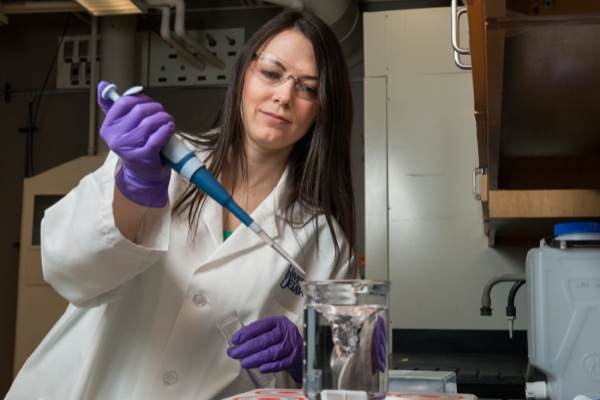
Brain cancer breakthrough
Nanotherapeutic that can cross blood-brain barrier reported in journal
10:59 a.m., Nov. 22, 2013--The University of Delaware’s Emily Day is a part of a team of researchers that has developed a nanotherapeutic capable of penetrating the blood-brain barrier.
Previously believed impossible, the groundbreaking development could have implications in the treatment of Glioblastoma multiforme (GBM), a lethal form of malignant brain tumors that is considered one of the deadliest human cancers. It may also benefit research for neurodegenerative diseases such as Parkinson’s disease, traumatic brain injury and multiple forms of cancer.
Research Stories
Chronic wounds
Prof. Heck's legacy
Led by researchers at Northwestern University, where Day conducted post-doctoral research, the team discovered that spherical nucleic acids (SNAs), tiny spherical gold nanoparticles densely coated with nucleic acids, have unique properties that allow them to pass through the blood-brain barrier and attack brain cancer.
The technology works by targeting Bcl2L12, a gene important in tumor progression.
“We believe that the SNA particles pass through by binding to scavenger receptors present in the cells lining the blood-brain barrier,” Day explained. “Once past the barrier, the SNA particles travel through the brain tissue and infiltrate tumor cells, where they interfere with the tumor cell’s genetic machinery to prevent the Bcl2L12 gene from being expressed.”
When administered systemically in cell and rodent models, the SNAs delivered nucleic acids to tumors without help from cationic carriers or other chemical modifications, lowered the expression of Bcl2L12 and effectively reduced tumor burden.
“Generally speaking we saw about a 20 percent increase in animal survival rates with this treatment, and a five-fold reduction in tumor growth without adverse side effects,” said Day, assistant professor of biomedical engineering at UD.
This discovery establishes SNAs as a promising new class of therapeutic gene regulation agents capable of treating disease through systemic injection, according to the research team’s findings published as a cover article in Science Translational Medicine, a publication of the American Association for the Advancement of Science.
Co-first authors on the paper were Day, Samuel Jensen and Caroline Ko, and their interdisciplinary team included researchers from Northwestern University’s departments of chemistry, biomedical engineering, molecular biosciences, neurology, neurobiology, and the International Institute for Nanotechnology. The research was led by Chad Mirkin, professor in Northwestern University’s Department of Chemistry, and Alexander Stegh, professor, in the Department of Neurology.
Future work on the project will include studies to determine safety and efficacy issues necessary for human trials and scaling the technology for manufacturing.
At UD, Day plans to continue exploring SNA behavior using nanoparticle materials such as silica core gold shell nanoshells, which she believes may be useful in imaging, photo thermal therapy and triggered released treatments based on their ability to convert light energy into heat.
“We’ve seen from years of cancer treatment that one single therapy won’t work. While the SNAs offer gene regulation, I’m interested in exploring whether combining this with a thermal base treatment will create more multifunctional and effective treatments for disease,” Day said.
About the professor
Emily Day joined the University of Delaware faculty as an assistant professor of biomedical engineering in fall 2013. Her research applies biomedical photonics and nanomedicine to create novel platforms for using nanoparticles for detecting and treating disease.
Day earned her doctoral degree in bioengineering at Rice University and completed her postdoctoral training in chemistry at Northwestern University with funding from the National Cancer Institute. She earned her bachelor’s degree in physics from University of Oklahoma.
Article by Karen B. Roberts
Photo by Evan Krape








